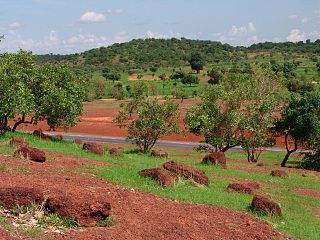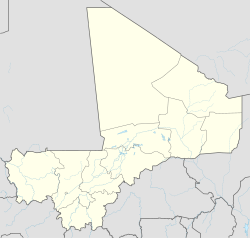
Bamba is a small town and rural commune in the Bourem Cercle of the Gao Region of Mali. The town is located on the left (north) bank of the Niger River, 190 km east of Timbuktu and 230 km northwest of the town of Gao. In the 2009 census the commune had a population of 28,524.

Kayes Cercle is an administrative subdivision of the Kayes Region of Mali. Its seat is the city of Kayes, which is also the capital of its Region and its largest city. The Cercle is further divided into Communes. The city of Kayes is subdivided into Urban Communes and Wards. Kayes Cercle's population in 2009 was 513,362.

Ménaka Cercle is an administrative subdivision of Ménaka Region, Mali. Its administrative center is the town of Ménaka. Ménaka Cercle's population as of 2009 was 56,104 people. Ménaka is located in the middle of the Sahara Desert, along Wadi Ezgeuret and an ancient dry river valley of the Iullemmeden Basin. Its highest point, Mount Abourak, is located around 150 km to the north of the town of Ménaka. Most of the small population are nomadic Tuareg tribal populations; minorities include the Wodaabe Fula and sedentary Songhai people. The area is a traditional center of the Kel Dinnik Tuareg confederation, along with the town of Andéramboukane near the Nigerien border.
Andéramboukane is a town and cercle in Ménaka Region, Mali. It lies at the extreme east of the country, several kilometers north of the Nigerien border. It was previously a commune in Ménaka Cercle but was promoted to the status of a cercle when Ménaka Region was implemented in 2016.

Tominian Cercle is an administrative subdivision of the Ségou Region of Mali. The administrative center of the local government is in the town of Tominian. The Cercle is divided into Communes, and below this, quarters/villages. In the 2009 census the cercle had a population of 219,853 people.

Niafunké Cercle is an administrative subdivision of the Tombouctou Region of Mali. The administrative center (chef-lieu) is the town of Niafunké. In the 2009 census the cercle had a population of 184,285. The Niger River runs for 100 km through the cercle.

Timbuktu Cercle is an administrative subdivision of the Tombouctou Region of Mali. It is the largest cercle by area in the whole of Mali. The capital lies at the city of Timbuktu. The cercle is divided into rural and urban communes, and below this, quarters/villages. In the 2009 census the cercle had a population of 124,546.
Niagadina is a village and rural commune in the Cercle of Kati in the Koulikoro Region of south-western Mali. The commune has an area of 87 square kilometers and includes five villages. The administrative center is the village of Niagadina which lies on the right bank of the Niger River, 72 km southwest of Bamako, the Malian capital. In the 2009 census the commune had a population of 11,961.
Diédougou is a rural commune in the Cercle of Dioïla in the Koulikoro Region of south-western Mali. The commune contains 34 villages. The administrative center (chef-lieu) is at the village of Béléko Soba which lies 205 km east of Bamako. In the 2009 census the commune had a population of 39,021.
Tidermène is a village and cercle in Ménaka Region of southeastern Mali. In the 2009 census it had a population of 5,816. Its area is approximately 29,000 square kilometers. It was previously a commune in Ménaka Cercle but was promoted to the status of a cercle when Ménaka Region was created in 2016. From 2001 to 2016 the commune of Alata was separated from Tidermène. On 12 April 2023, the town was seized by the Islamic State in the Sahel.
Sama Foulala is a village and rural commune in the Cercle of Ségou in the Ségou Region of southern-central Mali. The commune contains 7 villages in an area of approximately 154 square kilometers. In the 2009 census it had a population of 6,180. The village of Sama Foulala, is on the left (north) bank of the River Niger.
Katiéna is a village and rural commune in the Cercle of Ségou in the Ségou Region of southern-central Mali. The commune includes 27 villages in an area of approximately 998 square kilometers. In the 2009 census it had a population of 33,180. The Bani River runs along the southern boundary of the commune. The village of Katiéna is the (chef-lieu) of the commune.
Fatiné is a rural commune in the Cercle of Ségou in the Ségou Region of Mali. The commune includes 29 villages in an area of approximately 1006 square kilometers. In the 2009 census it had a population of 25,161. The Bani River runs along the southern boundary of the commune. The administrative center (chef-lieu) is the village of Fatiné Marka.
N'Koumandougou is a rural commune in the Cercle of Ségou in the Ségou Region of Mali. The commune contains 15 villages in an area of approximately 2,040 square kilometers. In the 2009 census it had a population of 14,237. The chef-lieu is the village of Doura.
Bellen is a rural commune in the Ségou Cercle in the Ségou Region of Mali. It is the most northerly within the cercle and is sparsely populated with only nine villages in an area of approximately 3,189 square kilometres (1,231 sq mi). In the 2009 census, it had a population of 6,949. The chef-lieu is the village of Sagala which is 89 kilometres (55 mi) northwest of Ségou.
Pelou (Pɛ̀:lú) is a village and rural commune in the Cercle of Bandiagara of the Mopti Region of Mali. The commune contains four villages and in the 2009 census had a population of 4,348.
Metoumou is a commune in the Cercle of Bandigara of the Mopti Region of Mali. The commune contains 22 villages and in the 2009 census had a population of 13,940. The main village (chef-lieu) is Damada.
Pignari Bana is a commune in the Bandiagara Cercle in the Mopti Region of Mali. The commune contains 23 villages and in the 2009 census had a population of 28,258. The main village (chef-lieu) is Goundaka.
Pignari is a commune in the Cercle of Bandigara in the Mopti Region of Mali. The commune contains 19 villages and in the 2009 census had a population of 14,630. The main village (chef-lieu) is Baboye.
Alata is a rural commune in the cercle of Tidermène in Ménaka Region of southeastern Mali. The administrative centre is at Tedjerit. The commune was created in 2001 by dividing the large rural commune of Tidermène. The implementation of Ménaka Region in 2016 led to the promotion of Tidermène to a cercle, and Alata was reincorporated into it. As of 2017 the mayor is Frataye Ag Etaw.






